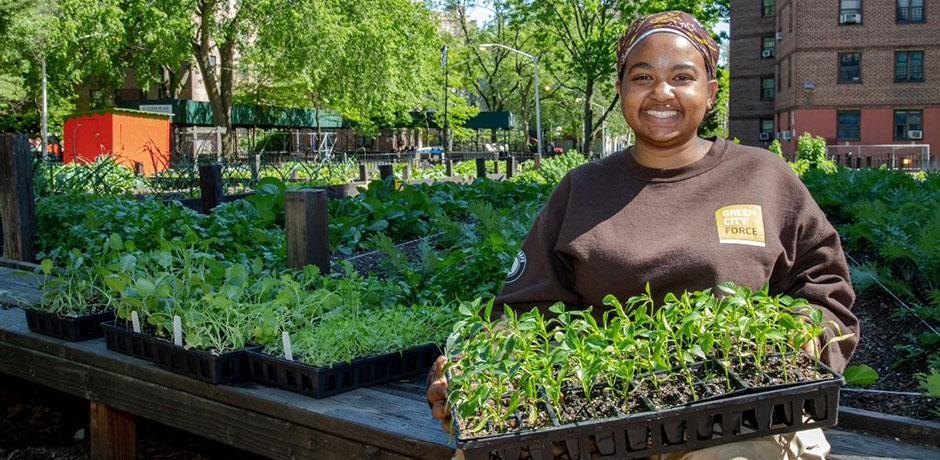Not known Details About City Blooming
Not known Details About City Blooming
Blog Article
City Blooming Things To Know Before You Get This
Table of ContentsExcitement About City Blooming7 Easy Facts About City Blooming ShownCity Blooming Can Be Fun For EveryoneUnknown Facts About City BloomingThe 45-Second Trick For City Blooming
Intrigued in expanding food available for sale in the City of Chicago? Thinking about starting a neighborhood garden? Modifications to the Chicago Zoning Regulation enable farming uses like community yards and metropolitan farms in numerous parts of the city. Below is a listing of frequently asked questions regarding the guidelines and laws that cultivators ought to consider when preparing a metropolitan agriculture project.
The zoning modification does not change any kind of various other codes taking care of composting, building permits, acquiring or leasing City possessed home, business licenses or environmental contamination. There are existing codes that regulate these issues and they continue to be in complete effect and may be suitable to your job. Area yards are usually had or handled by public entities, civic organizations or community-based organizations and kept by volunteers.
Urban farms expand food that is meant to be marketed, either on a nonprofit or for-profit basis. As a result of their commercial objective, metropolitan ranches require a business license. Yes. A community garden is enabled to sell excess create that was grown on site if the sales are accessory or subservient to the yard's main purpose defined over.
7 Easy Facts About City Blooming Explained
Composting is enabled however only for plant material that is created and used on website. The amount of garden compost product can not surpass 25 cubic backyards at any kind of provided time according to the standards in 7-28-715 of the City's Municipal Code. Yes. Because the soil at the majority of brand-new garden sites requires amending, compost, dirt, timber chips, or other products can be gotten to construct or enhance the growing area - balcony and patio garden design.

If a structure license is needed after that the hoophouse will certainly be thought about an accessory structure. You can learn even more concerning the building license demands by speaking to the Department of Structures. The 25,000-square-foot dimension restriction is meant to stop a solitary area garden from dominating a provided block or taking away from the block's existing residential or business character.
The limitation does not use to yards situated in Public Open Space (POS) areas. Can there be even more than one community garden that is 25,000 square feet on a single block? Yes. The dimension limit puts on specific gardens, not to private blocks. No. Fencing is not required, however, yards that have big parking areas may be needed to install secure fencing or other landscaping attributes.
City Blooming for Beginners
B1 & B2 areas call for that all commercial use activities be carried out inside. R areas restrict industrial task. The regulations mirror the purpose and intent of the Zoning Code. Is fence needed for city ranches? Yes. Fences might be needed, in addition to landscape design and testing, for specific car parking areas and outside work or storage space locations relying on area and the certain task occurring.
Urban ranches need structure licenses and zoning approvals prior to construction (urban gardening). Other kinds of city review might be called for depending on particular structures, tasks, size, landscaping, licensing, public heath and stormwater administration issues.
The Division of Business Affairs and Customer Protection can help establish the details kind of business permit that's needed. Off road car park is needed for most business tasks in Chicago. The required number of parking areas is based on the number of staff members working on website and not the square footage of the growing area.
City Blooming for Dummies

A metropolitan ranch can sell compost material produced on website, however, the operation has to conform with the from this source laws in 7-28-715 of the Chicago Municipal Code. Aquaponic systems are enabled indoors on urban farms in several zoning districts.
Up to 5 hives or colonies of honey bees may be kept as an accessory usage. However, beekeepers need to register with the Illinois Department of Agriculture. For more details regarding the recommended zoning change you may contact the Department of Housing and Economic Advancement, Bureau of Planning and Zoning at 312.744.8563.
Farming in cities and metropolitan locations A city farm in Chicago. Urban farming refers to different practices of cultivating. https://www.ted.com/profiles/47172561, processing, and distributing food in urban areas. The term also relates to the area activities of animal husbandry, tank farming, beekeeping, and cultivation in a city context. Urban agriculture is differentiated from peri-urban agriculture, which takes area in country locations beside suburban areas.
The 20-Second Trick For City Blooming
It can entail a motion of organic cultivators, "foodies" and "locavores", who seek to create socials media based on a shared ethos of nature and area holism. These networks can establish using formal institutional assistance, ending up being incorporated into neighborhood town as a "change town" activity for sustainable city advancement.
Some of the first proof of urban agriculture comes from Mesopotamia.
Report this page